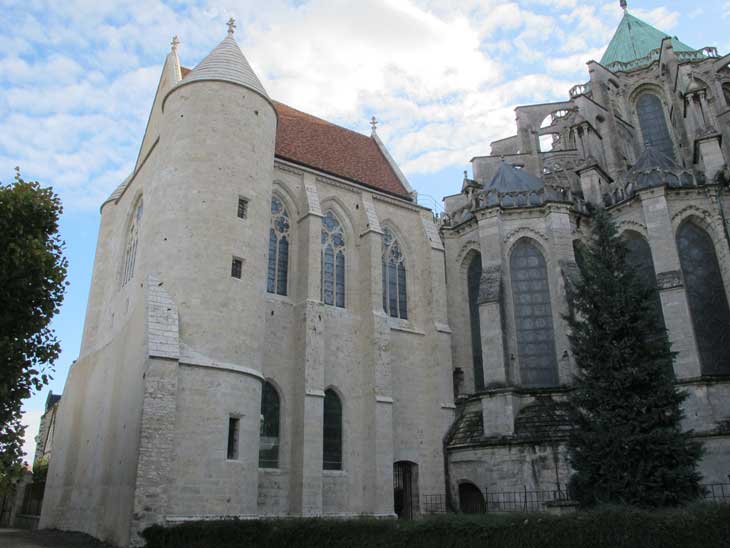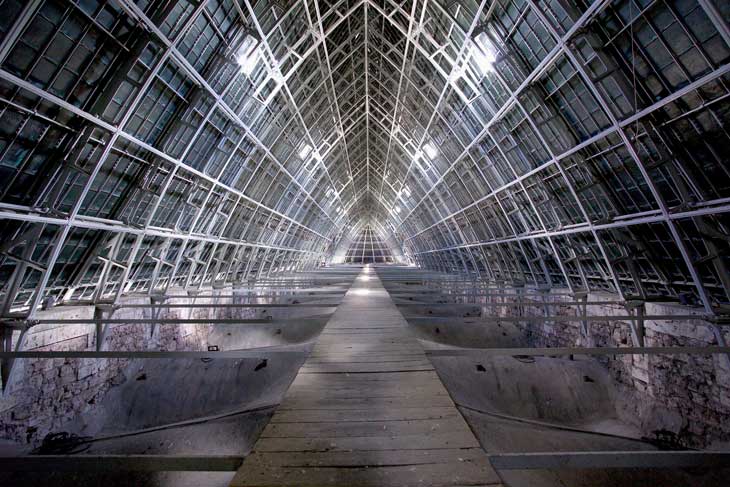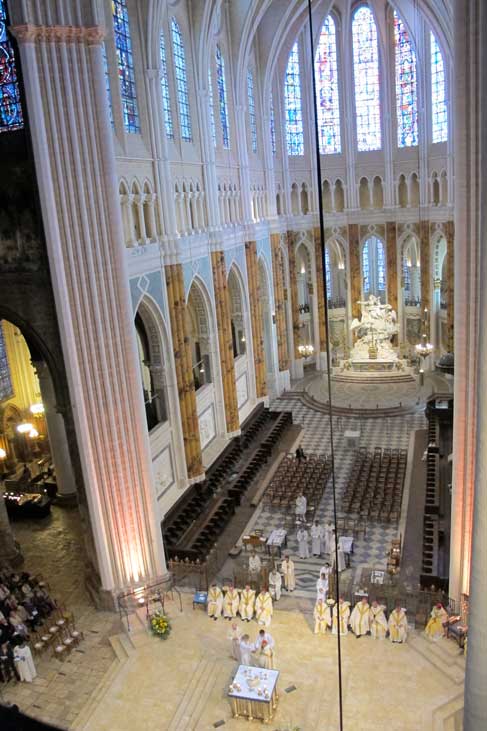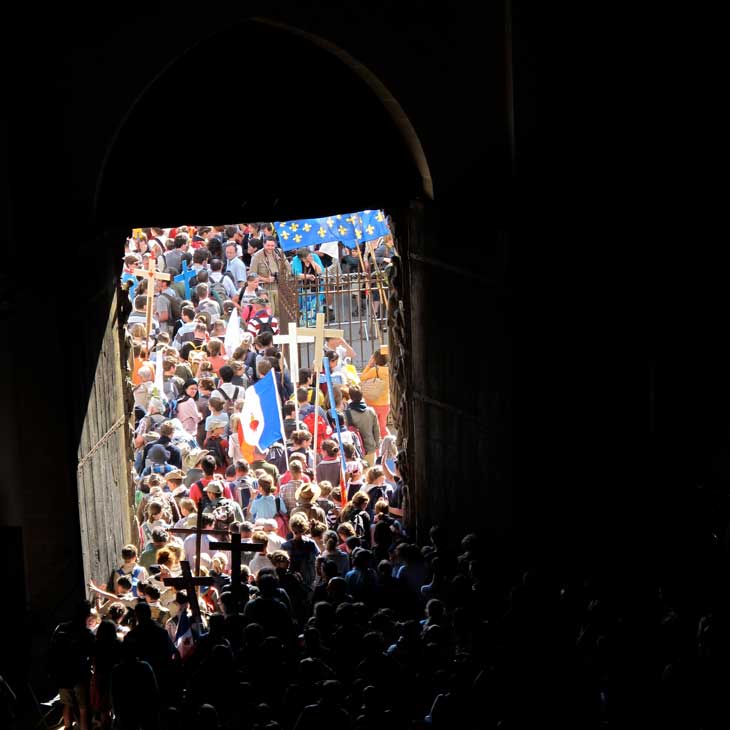By Nicolas Reveyron, Lumière University Lyon-2
courtesy of Chartres Sanctuaire du Monde

Restored and transformed, the Saint-Piat chapel was first used as a chapter house, then as a bishops’ vault and, in the 21st century, will soon house the cathedral’s treasury.
In the 12th-century Chronique des Ducs de Normandie, Benoît de Saint-Maur gives thanks to the dukes for having “restored to new splendor the cities that had been destroyed and the churches that had been knocked down”.
At the time, the notion of restoration was not new. It had appeared much earlier in history, but in the Middle Ages, in Antiquity, at the time of Viollet-Le-Duc or today, what does it mean to restore? Repair, rebuild, embellish, maintain, consolidate…?
Beyond the differences in action and purpose, these verbs reveal a common intention: to exalt and perpetuate a past reality that underpins the present.
1 – Repair, Restoration, Reconstruction
When Eugène Viollet-Le-Duc set about rebuilding the 13th-century spire of Notre-Dame de Paris, destroyed in the late 18th century, he sought out the remains, fortunately preserved in the cathedral’s attic, of the original Gothic structure. Based on its technical and geometrical characteristics – overall volume, cross-sections of the timbers that convey its power, beam angles, articulation of the parts, counter-balance, anchorage in the roof structure – he reconstituted a spire similar to its lost model, but larger and more richly ornamented, as evidenced in the 15th-century figurations of Notre-Dame by Jean Fouquet.
Another philosophy of restoration is that of maintaining a building, without intervening more heavily in its appearance or structure. An art historian, archaeologist and formidable polemicist, Adolphe Napoléon Didron (1806-1867) was a colleague of Mérimée, Hugo, Lenoir, Vitet et alii, all young and dynamic promoters of medieval architecture in great danger of disappearing, within the Comité historique des Arts et Monuments created by Guizot. His thoughts on the conservation of historic monuments are extraordinarily modern: “In the case of ancient monuments, it is better to consolidate than to repair, better to repair than to restore, better to restore than to remake, better to remake than to embellish; in no case should anything be added, especially nothing be subtracted” (Annales archéologiques, 1839). With this in mind, he demanded that the wounds made in the walls of Saint-Germain-l’Auxerrois by the fighting of the 1830 revolution should not be erased, so that they might bear witness to history.
2 – Restoration and Authenticity
A building is the present result of past actions: the deeds are gone, the monument remains. Its materials – stone, wood, metal, glass, mortar – hold its memory. They carry with them and within them the imprints of the actions (tool marks, scaffolding holes, reworkings…) and men (lapidary signs, regulatory tracings, inscriptions…) that produced them. They are thus a sign of authenticity. That’s why international charters of standards for the restoration of historic monuments advocate the conservation of original materials, the very relics of the past that have come down to us, and call for the visual marking of the boundaries between original masonry and refurbished facings. The practice dates back to the earliest times. In the temple of Shamash, in Mesopotamia in the second and first millennia, the bricks are engraved with the names of the restoring kings and, in some cases, with a commentary on the restoration itself; the formula makes it possible to locate the chronology of the work on the walls. At Notre-Dame de Paris, it’s the freshness of the facings that ensures this function, but also the reactions of the original blocks, often degraded by the insertion of new stones whose lithic qualities, too different, and new chemical additions, through aggressive contact, disturb the conservation of the old walls.
But if the authenticity of the construction deserts the materials, what remains of the building’s authenticity? Have restorations made it disappear with the old facings duly replaced? In fact, this crucial question brings us back to the dialectical relationship between materials and architecture.

In the 19th century, the metal frame replaced the wooden frame, which was completely destroyed by fire in 1836.
Architecture is in fact a mental object (cossa mentale, as our Italian colleagues would say) that is embodied – or rather, petrified – in materials. If a building loses authenticity through restoration, it retains the authenticity of its architecture, thanks to the faithful reproduction of forms and decorations. And even if he exceeded the limits we set ourselves today, Viollet-Le-Duc, in his projects for Paris Cathedral, respected a certain idea of Gothic art in general and Notre-Dame in particular, thanks in particular to the dialogue he assiduously maintained with Villard de Honnecourt, an architect-engineer who died some six centuries before him. Sometimes, however, the pure idea is more enduring than the material. The example of the great Shinto sanctuary of Ise, founded in the 7th century not far from Kyoto, illustrates this astonishing paradox: since the cult buildings, made of Japanese cypress wood, are rebuilt identically every twenty years, the architecture is thirteen centuries older than the building 1.
1 J.-S. Cluzel, Architecture éternelle du Japon, de l’histoire aux mythes, Dijon, Éditions Faton, 2008.
3 – Restoration and Processing
The architecture of the Western Middle Ages reflects an anthropological constant. When asked by the abbot of Monastier-sur-Gazeille (Haute-Loire) whether he could move his abbey to a more favorable site, Hugues de Semur replied that it should remain in the place of its origins, which the presence of the monks had sanctified century after century.
In fact, in the Middle Ages, the reconstruction of a church was part of a homotopic construction process, i.e. on the same site as the building to be replaced: to ensure the continuity of ceremonies, the old building was preserved in the middle of the work as long as it did not interfere with the erection of the new church, then destroyed in successive stages as construction progressed. Archaeology has shown how churches were built one on top of the other on the same site. The sacredness of the site is sometimes highlighted by the altar, when it is always located in the same place. At Reims Cathedral, for example, the main altar, built at the transept crossing, has never changed location. Under these conditions, can each building be considered a restoration of its predecessor? No, insofar as its plan, elevations and decoration are new.
On the other hand, it can be said that the new church reflects the restoration of the institution it houses. Indeed, its reconstruction often coincides with a 5 reform of canonical or monastic life, which, thus regenerated, takes its place in a building that is as new as itself. The definition of the word “restoration” in modern dictionaries is no different.
Furetière’s dictionary, in its 1724 edition: “Restoration, in architectural terms, is the repair of all the parts of a building that has deteriorated and decayed through malfeasance or the passage of time, so that it is restored to its original form, and even considerably increased”. This definition is illustrated by the example of the Château de Saint-Germain-en-Laye, restored and enlarged by Louis XIV: in restoring a monumental glory tarnished by the Fronde episode, the king also gave the château back its institutional significance 2.
2 N. Reveyron, « Pour une histoire du mot restaurer », in B. Phalip et F. Chevalier (dir.), Pour une histoire de la restauration monumentale (XIXe-début XXe s.), Clermont-Ferrand, Presses Universitaires Blaise-Pascal, 2021, p. 43-58.
4 – Notre-Dame de Chartres ?
Notre-Dame de Chartres has not been spared by history: the roof frame has burned to the ground, the Berchères stone has stood the test of time, and the north spire is now under threat. The monumental acoustics have not been altered, but the great organ must be completely rebuilt. The stained glass windows are gradually being restored, a huge project that began half a century ago but is now drawing to a close. The elevations are finally regaining the brightness of their original plasterwork. And the cathedral still towers above the surrounding houses. No tall buildings to hide the daylight, no modern stained-glass windows too pale or too dark, no more grime on the walls. Today, all of architecture is combining its efforts to restore another, more subtle, fragile and powerful reality: the light of the cathedral, as the builders intended it to be. In a miracle that continues to unfold today, light and song combine under the vaulted ceiling, echoing in the upper fifth and octave the voice of the angels, who sing in unison with mankind, just as they did in the 13th century.
Original article published in Lettre de Chartres Sanctuaire du Monde (December 2021)

